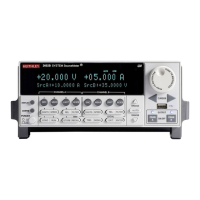18-70 SCPI Command Reference 2400 Series SourceMeter
®
User’s Manual
TRIPped?
[:SENSe[1]]:CURRent[:DC]:PROTection:TRIPped? Query current compliance state
[:SENSe[1]]:VOLTage[:DC]:PROTection:TRIPped? Query voltage compliance state
Description This command is used to determine if the source is in compliance. If a
“1” is returned, then the source is in compliance. A “0” indicates that the
source is not in compliance.
The :CURRent:PROTection:TRIPped? command is used to check
the compliance state of the V-Source, and the
:VOLTage:PROTection:TRIPped? command is used to check
the compliance state of the I-Source.
Set measurement speed
NPLCycles <n>
[:SENSe[1]]:CURRent[:DC]:NPLCycles <n> Set speed (PLC)
[:SENSe[1]]:VOLTage[:DC]:NPLCycles <n> Set speed (PLC)
[:SENSe[1]]:RESistance:NPLCycles <n> Set speed (PLC)
Parameters <n> = 0.01 to 10 Power-line cycles per integration
DEFault 1
MINimum 0.01
MAXimum 10
Model 2430 Pulse Mode:
<n> = 0.01 to 0.1 Power-line cycles per integration
DEFault 0.1
MINimum 0.01
MAXimum 0.1
Query :NPLCycles? Query programmed PLC value
:NPLCycles? DEFault Query *RST default PLC
:NPLCycles? MINimum Query minimum PLC
:NPLCycles? MAXimum Query maximum PLC
Description This command is used to set the integration period (speed) for measure-
ments. NPLC (Number of Power Line Cycles) expresses the integration
period by basing it on the power line frequency. For example, for a PLC
of 1, the integration period would be 1/60 (for 60Hz line power) which
is 16.67 msec.
Note that this is a global command. Thus, if you set the speed for volt-
age measurements to 10 PLC, then current and resistance will also set to
10 PLC.
NOTE For the Model 2430 Pulse Mode, speed can be set from 0.004 to 0.100 PLC.
Artisan Technology Group - Quality Instrumentation ... Guaranteed | (888) 88-SOURCE | www.artisantg.com

